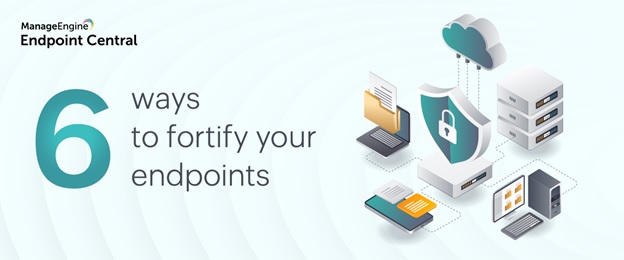Essential endpoint security strategies for IT admins
When it comes to endpoint security, any oversight could allow a threat actor to penetrate your organization with ease. While your IT admins focus on bolstering endpoint network security, a threat actor focuses on finding any loopholes, making it all the more difficult to stay protected. Moreover, for every corner cut on security to improve productivity, the attack surface grows. Keeping your organization's network safe all comes down to planning and executing a proper security framework.
An endpoint security tool will help address the multiple backlogs in your organization's endpoint protection. Not only does the integrity of the endpoint security tools determine security strength, but also how wisely these tools are utilized. For an effective endpoint security solution, make sure you're starting with two things: establishing visibility and securing access.
Collaborate your workspace for in-depth insights
The first step in endpoint security is visibility, since data drives the strategies and policies implemented by your endpoint security team. However, implementation is slowed down with protocols and hierarchy, leaving room for threats to sneak in.
To avoid this, install an architecture that caters to the executive level of your organization. Core technicians can work on the management and monitoring of these endpoints, and your CISOs and SOCs can supervise all the functions from a dashboard that displays real-time data. This offers a degree of freedom for IT administrators with dedicated workspaces for all levels of employees in the endpoint management team.
Get the hang of authentication
With a collaborative workspace for your endpoint security team in place, the next step is to set the proper networking access and authentications. To increase security while allowing users to access corporate data, implement Zero Trust. Based on the ideology of "never trust, always verify," this approach places a ring of authentication at every possible check point to authenticate the user or device trying to access data.
If a threat actor breaches an endpoint in your network, an easy step to prevent the spread of malware is to isolate the infected device from your network. To quarantine the device, implement network access control (NAC) policies to restrict access to non-compliant resources.
After establishing a visible workspace and implementing security protocols like Zero Trust, you can use the following practices to bolster your endpoint security:
Automate threat detection and remediation
Vulnerabilities impose countless security risks. To patch them one by one is time-consuming for an IT admin and leaves the rest of your network open to attack. Automate threat detection and patch implementation to keep the chaos out of your network.
Endpoint accessories checkup
End users hold a lot of corporate information and confidential data inside their devices. IT admins are responsible for restricting or granting access to external drives that will connect to these devices, plus monitoring the applications, browsers, operating systems, and all back-end technology on them. IT admins should exercise formal control over the accessories in the endpoint network to ensure overall security.
Gear up with intelligence protocols
The attack surface is shapeless. Threats emerge from unexpected factors. To tackle these, IT admins should employ intelligent technology. With anti-ransomware powered with AI and ML, any anomaly that enters or lurks inside the business network can be flagged and discarded automatically.
Design smart security strategies
Today's IT admins have the major challenge of managing corporate-owned devices and personal devices, thanks to BYOD policies. Today's personal devices are in constant motion, accessing confidential resources from a range of networks, and therefore require a dynamic security strategy. Here are the essentials when it comes to securing the personal devices in your network:
- Track the devices: Since modern devices are mobile in nature, keep an eye on their location with geo-tracking while maintaining compliance.
- Locate and wipe remotely: Track and erase corporate data on a stolen or missing device before it falls into the wrong hands.
- Data encryption: Encrypt all corporate data kept on personal devices and thwart potential threat actors.
- Staple security to emails: Govern and authenticate access to emails from personal devices. Secure authorization and scan email attachments with conditional exchange access.
A complex problem with a simple solution
With an array of security measures to implement, IT admins often juggle between various software, tools, and technologies. Instead, they should find a unified tool that delivers everything needed for comprehensive endpoint security.
Endpoint Central from ManageEngine is an extensive endpoint security solution that can assess vulnerabilities and eliminate them in a jiffy. With a combination of reactive and proactive security measures, plus real-time dashboards for all of your assets, Endpoint Central will help your organization steer clear from threats. Start your experience with a 30-day, free trial!
Author bio
Nisangan is a speaker and technical specialist with ManageEngine who has a keen interest in cybersecurity. He specializes in cybersecurity and endpoint intelligence to provide the right solution to the businesses looking to secure their IT.

